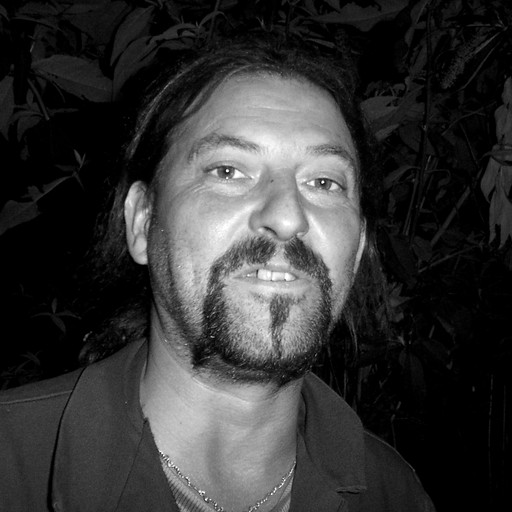Kálmán Várady was born in 1958 in Hoffnungsthal, Germany, and now lives and works in Cologne. A 1984 graduate of the Academy of Media Arts Cologne, he gained his MA from the same institution in 1986 under professor Werner Schriefers. During his studies and in the 1990s he made numerous extended trips to Africa, North and South America which have significantly influenced his work.
For Várady, nomadism is less of an economic necessity than a horizon-broadening way of life. With an oeuvre that embraces painting, sculpture, installation and photography, he explores these mediums in ever-new combinations. Using various objects that he finds and collects during his trips around the world or at Cologne’s flea markets, he creates sculptures and installations that are often reminiscent of a shrine, altar or totemistic figure. Inspired by the symbolic objects of various cults or religions (ranging from Voodoo or the Catholicism of Cologne and Mexico to Buddhism), these works carve out a kind of meta-religion and explore magic, rituals, sacrifices and death.
His works are often surrounded by a spiritual aura, but at the same time a highly characteristic sense of humour, through which any unambiguous interpretation is skilfully evaded. An ever-present theme in his works is danger: it tells of death and the ephemeral and the exotic at the same time. Traditional vanitas motifs and traces of corrosion and weathering stand side by side. The idea of exoticism, which is adhered to as cliché and as one of the stereotypes of Sinti and Roma, is reduced to absurdity.
The gilded bullets shown in the exhibition Gypsy Warriors symbolise the permanent danger in which one finds oneself as human in general and as Roma in particular, but they also remind the viewer of the preciousness of our lives. Having long explored totemic art and the play with altars, magical figures and private cults, Várady now addresses his Roma identity increasingly on an artistic/political level. His 2008 photographic series Familija was based on the typological record of Sinti and Roma in work conducted in the Nazi era by Dr Robert Ritter’s research institute for ‘racial hygiene’. A photographic series of Várady and his six daughters shot in a police identification style, it refers both to the actions of the National Socialists against Roma as well as to current discriminatory practices. His piece Fleischerblock, a used, gilded butcher’s block with a deportation number stamped on it, also deals with the Porajmos, commemorating the millions of murdered Sinti and Roma whose few possessions were seized by their slaughterers for personal gain.
Selected Solo Exhibitions
1984
Loko Aganzum, Voodoo – Wachsfabrik, Cologne
RAP Gallery, Maastricht
1989
Galerie Sysyphos, West Berlin, West Germany
Duna Gallery, Budapest
1990
Voodoo – Galerie Kunstgarten, Cologne
Duna Gallery, Budapest
1995
Herkunft–Zukunft – Stadtmuseum, Siegburg
Galerie Hofstadt, Frick
1997
Je retour de Dakar – Galerie Seidel, Cologne
2000
Galerie im Turm Bürgerhaus Stollwerk, Cologne
2002
Galerie Herbert Schäfer, Cologne
2013
Gypsy Warriors – Galerie Kai Dikhas, Berlin
2014
Stopping Places IV – Galerie Kai Dikhas, Berlin
Romamor – Galerie Display, Cologne
2015
La Famiglia – Galerie Kai Dikhas, Berlin
25 Years of Art – Stadtmuseum Siegburg, Siegburg
Kaum zu Glauben – Galerie Schwingeler Hof, Wesseling
2017
Wunderkammer I – Galerie Kai Dikhas, Berlin
Selected Group Exhibitions
1984
Simultanhalle, Cologne
1987
Werkschule Köln, Cologne
1988
Grafik der Gegenwart – Arbeiterwohlfahrt, Bonn
1989
Galerie im alten Kloster, Cologne
1991
BASTARTS artists group, Osteuropäisches Kulturzentrum, Cologne
1993
Vasarely Museum, Budapest
1994
Art Multiple Düsseldorf, Kunstverein Langenberg
ART Cologne, Kunstverein Langenberg
1995
Tohuwabohu – Deutsche Welle, Cologne
1997
Free Tibet – Osteuropäisches Kulturzentrum, Cologne
2000
Tuchfühlung I – Kunstverein Langenberg, Lippisches Landesmuseum
2002
Jump Shit Rat – Jump Shit Rat Gallery, 25 Jahre Städtepartnerschaft, Cologne–Liverpool
Motherboard – Deutsches Museum Bonn
2003
Motherboard – Fraunhofer Gesellschaft für Graphische Datenverarbeitung IGD, House Art, Darmstadt
2006
Motherboard – Fraunhofer Haus München, in the ‘Art meets Science’ series
2009
Die vergessenen Europäer: Kunst der Roma. Roma in der Kunst – Kölnisches Stadtmuseum, Cologne
Verloren Paradijs – Roma art, International Gipsy Festival, Het Duvelhok, Tilburg
2011
Armut: Perspektiven in Kunst und Gesellschaft – Rheinisches Landesmuseum Trier and Stadtmuseum Simeonstift Trier
Armut – Museum für Brotkultur, Ulm
Aire compartiblo – Museo del Arte Moderno Toluca, Mexico
2012
Alone Together: Kultur der Sinti und Roma zwischen Verfolgung und Emanzipation – Lew Kopelew Forum, Cologne
Europe, Pays de mon enfance – Carreau de Cergy, Paris
Voodooaltar Installation ‘Loko Azamgun II’ – St. Michael, Cologne
2014
Akathe Te Beshen / Here to stay. Zeitgenössische Kunst der Roma und Sinti in Europa und die Kunst Otto Pankoks – Kunststation, Kleinsassen
Kathe Ham Mer Kheri / Hier sind wir zu Hause – Staatsgalerie Stuttgart
Ruhe-Störung: Streifzüge durch die Welten der Collage – Marta Herford, Ahlen Art Museum
2015
25 Jahre Kunst im Stadtmuseum Siegburg – Siegburg
Transmittting Trauma: Zeitgenössische Reflektionen zum Genozid an den Sinti Roma – Gallery8 and Galerie Kai Dikhas, Budapest/Berlin
Stopping Places V – Galerie Kai Dikhas, Berlin
2016
Akate Te Beshen – CentroCentro, Madrid | Galerie 59 Rivoli, Paris
Frei Sein! – Galerie Kai Dikhas, Berlin | Schloß Heidelberg - Ottheinrichsbau
2017
Akate Te Beshen – Galerie Českých, Prague
Source: Akathe Te Beshen catalogue, Galerie Kai Dikhas, 2014; www.kaidikhas.com/en/artist/kaelmaen_vaerady/biography




